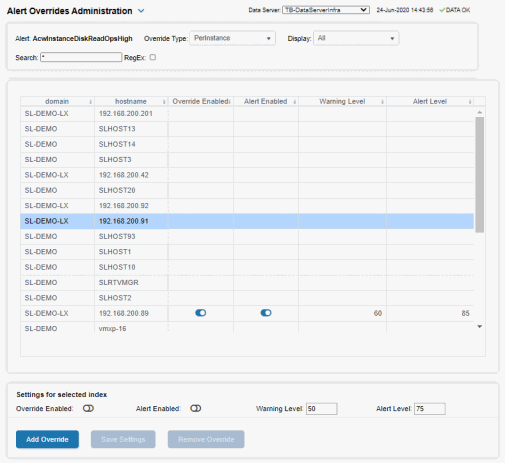Alert Overrides Administration
Administrators use this display to override the alert settings defined in the Alert Administration display. To access this display, select an alert in the Alert Administration display and choose Override Settings.

The table lists all the possible overrides that can be defined for the alert you selected from the Alert Administration display. Each row in the table represents a different resource or group of resources that can be overridden. When the four last columns are blank, that means the resource has not been overridden, and the default settings for the alert apply. Otherwise, columns describe whether the alert is enabled, if the override itself is enabled, the overridden alert thresholds and the overridden duration for each row.
Use the Override Type drop-down menu to switch the list to a specific type of override (the options for this menu vary according to the alert type), and use the Display drop-down menu to list All resources, Overridden resources or Free resources.
You can also enter a pattern or regular expression in the Search string to limit the list.
The RegEx checkbox indicates whether the text you entered is treated as a search pattern or as a regular expression. Multiple rows can be selected to create/edit/remove many overrides simultaneously.
You can filter, sort and choose columns to include by clicking a column header icon (located to the right of each column label) and selecting Filter, Sort Ascending, Sort Descending or Columns. Use the Display drop-down to filter the table to show All resources, only resources with the Overridden alert applied or Free resources (to show only resources without the alert override applied). Right-click on a table cell to Export to Excel or Copy Cell Value.
To set overrides:
Select an Override Type from the drop-down menu (depending on the alert, there might be only one type) and then select one or more rows from the table. Under Settings for selected index (in the lower portion of the screen), modify settings for the Override Enabled, Alert Enabled, Alert Delay, Warning Level and/or Alarm Level, then click Add Override. The table updates with your new settings.
To alter overrides:
To alter existing overrides with new settings, select them from the table, set all properties under Settings for selected index as desired, then click Save Settings. To clear existing overrides, select one or more rows, then click Remove Override.
Note: You can override alert and warning levels without overriding duration by setting it to -1.
For alert indexes that were overridden in a previous release (before duration override was supported) the override duration is set to -1, indicating that this is set to use the top level alert duration.